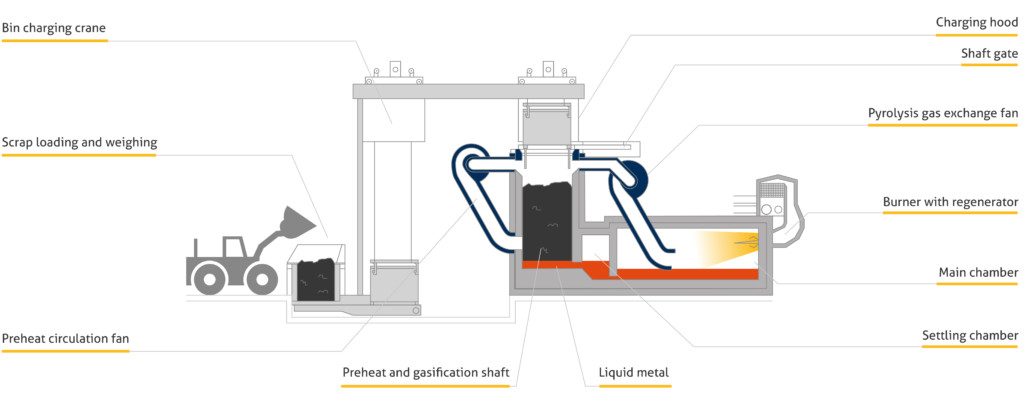
Aludium has announced that the company will install a multi-chamber furnace to reduce metal costs and improve the sustainability of its operations. The new furnace will be installed in the Amorebieta cast house and will increase Aludium’s ability to melt lacquered scrap. That will enable Aludium to create one of the most flexible metal production units in the world. The €20 million investment is due to come onstream during 2019.
The multi-chamber furnace selected is a Hertwich Ecomelt PS275, a proven technology and one of the largest shaft furnaces in the world. The PS275 is a top-loading system and can be charged with many different types and shapes of scrap and has a throughput of 275 tonnes per day.
The PS-type furnace ordered by Aludium Amorebieta is suitable for scrap with the highest contamination rates. The scrap is fed into a preheating shaft from above through a material lock. The hot gases flow through the charged material in the shaft from the bottom upwards. The pyrolysis gases produced during this stage are combusted in the main chamber.
Thanks to the advanced design of the furnace, the reuse of the pyrolysis gases reduces gas consumption to around 300 kWh/tonne (depending on the scrap input). This reduces operating costs, increases the sustainability of Aludium’s operations, and results in minimal emissions of gases including CO2, CO, NOx, dioxins, volatile organic compounds (VOCs), and salts.
All melting technologies under one roof
“With the installation of the new multi-chamber furnace, Aludium will have a range of furnaces of different sizes and all melting technologies on one site. That will enable us to produce slabs in the most flexible way,” explains Mario Allet, Program Director.
The Aludium Amorebieta cast house already houses three standard reverb melting furnaces which utilise primary metal and clean scrap as feedstock. It also contains a rotary furnace which runs in batch mode, allowing the cast house to quickly change the alloy produced. Many different types of scrap can be melted in the furnace including painted scrap and dross.
By contrast, the multi-chamber furnace operates continuously and will produce large volumes of alloys from the 3xxx and 5xxx families. The de-coating and re-melting process steps are separated to maximise recovery and production.
External after-burning is not required as all emerging pyrolysis gases are combusted in the main chamber in a controlled manner. At the lower end of the shaft, the pre-heated and de-coated material is immersed in the melt bath which is moved by a liquid metal pump. The material melts instantaneously with minimal melt loss.
The melting furnace includes a separate feed for scalper chips. These are fed into the furnace immediately after rolled slabs are machined. They are also melted using the submersion melting process, ensuring the greatest possible yield.
Multi-chamber furnace increases sustainability of Aludium’s operations
When it comes onstream in 2019, the new multi-chamber furnace will be able to melt up to 55,000 tonnes of painted or thin scrap annually. Compared to primary metal production, recycling aluminium reduces energy consumption by 95% or 14 megawatt hours (MWh) per tonne of aluminium. With this project, Aludium expects to reduce CO2 emissions by 250,000 tonnes annually.
During the works to install the furnace, the existing scrap yard in Amorebieta will be enlarged and a new 65-tonne scrap holder will be installed. The unit will be optimised for safety including features such as a hands-free casting machine. The entire system will also comply with OHSAS 18001 and European standards.
The total cost of the investment is €20 million. Work on the improvements and furnace installation are scheduled to begin during the first half of 2018 and will take 18 months in total. At the same time, pit #3 will also be enlarged to allow five sheet ingots to be cast in each drop. The multi-chamber furnace is expected to become fully operational in the second half of 2019.
